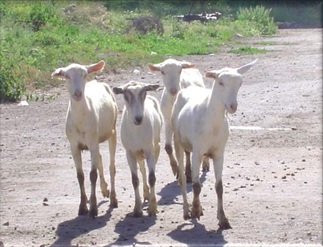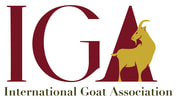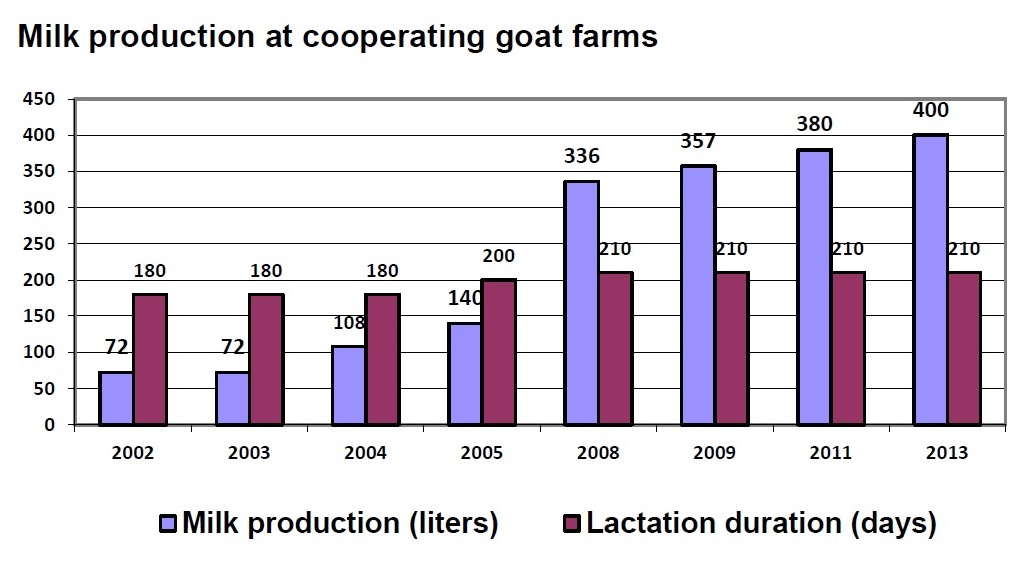 Written by Narine Babayan Republic of Armenia Total surface area: 29.800 km2 Permanent population: 3.2 million Share of agriculture in the economy: 46 % Arable land: 280.793 ha Livestock numbers Cattle: 677,584 Sheep: 687,074 Goats: 30,500 Pigs: 139,799 Armenia is a small, mountainous, landlocked country with few natural resources. With an area of 29,800 km2, it borders Georgia, Azerbaijan, Iran, and Turkey. Following independence in 1991, policy reforms also included the privatization of the agricultural sector. Large state farms that had dominated the agricultural sector during the Soviet Union were disbanded. The dairy industry was depreciated and milk was consumed at the household level. Milk yields were low and processing conditions poor. The traditional animal husbandry and food processing methods did not meet the requirement to satisfy consumers. The low milk yield of native dairy goats and the lack of industrialization experience were the reason to consider goats as a small ruminant species for development. The milk production of native breeds is low (100 liters for 120 days of lactation season), resulting in inefficient farming. Efforts from national and international agencies towards agriculture development in Armenia led to improvement in living standards, and increased rural development and economic growth in rural areas. Livestock development was approached to provide high quality agro-products to satisfy the market demands among consumers as well as increased incomes at the farm level. In 2000, the United States Department of Agriculture (USDA) started a cattle and goat genetic improvement program in Armenia in close collaboration from the Armenian Agrarian University and the Armenian Ministry of Agriculture. The native breeds that have special adaptive traits such as disease resistance, adaptation to the local climatic conditions, the ability to digest low-quality feed and to survive with reduced or uncertain supplies of feed and water are the “basic sources” for the ongoing genetic improvement project. The Goat Industry Development Project (GIDP) was launched by the USDA to aid Armenian agriculture in developing an independent and economically viable dairy goat sector, product manufacturing, and marketing industry through technology transfer. Within the framework of USDA’s GIDP, USDA collaborated with the only goat research institute of the United States, the E. Kika de la Garza Institute for Goat Research from Langston University, to develop a breeding program for recording, selection, and multiplication of improved goat genetics. Local villagers were eager to receive crossbred goats from Western and local Armenian germplasm, and so the Armenian Improved Dairy (ARID) Goat Center became an official breeding center in September 2000. The Center is located in Vayots Dzor marz, Yeghegnadzor, in Southeastern Armenia. The components of the GIDP project are: cooperatives and individual goat farms, associations, milk collection units and cheese factories, the ARID Goat Center as a repository for improved goat genetics and for training in appropriate goat farming practices. The ARID Goat Center breeding program focuses on the genetic improvement of the domestic Armenian goats through successive generational crosses to high producing animals of four dairy breeds, the Saanen, Alpine, Toggenburg and Nubian breeds. With the assistance of the USDA, 30 purebred goats were imported from the USA in May 2000. As on 1 April 2014, the 129 purebred goats housed at the ARID Goat Center and over 4000 crossbreds located in the cooperating farms represent the expanding population of the germplasm imported initially. Annually, more than 125 beneficiaries (goat farmers, cheese producers, veterinarians, extension and breeding specialists, fodder producers, employees, etc.), get involved in the project activities, of which more than 36 women and 75 children from rural areas. Activities of the ARID Goat Center within the framework of the GIDP are as follow: 1. Service provision on
2. On farm research - done independently and with Agrarian University scientists’ participation
3. Technical assistance to producers, extension personnel, agribusiness, students and youth
4. Training and education for producers, extension personnel, students and Youth
5. Youth project implementation The main achievements obtained from the project implementation are:
The imported goats are well adapted to the environmental conditions of Armenia and due to this project the number of goats is much increased all over the country. In 1999 there were 12,000 goats and as of 2013 there are 35,000
Developing small, medium enterprises in the dairy sector has played a significant role for providing jobs, increasing farm income and improvement of overall livelihood of the rural population in the targeted communities. Nevertheless, market opportunities have to be expanded and improved to ensure the sustainability of food production and agriculture development. Due to the improvement of farm and herd health management and breeding and AI programs implemented by the ARID Goat Center, the efficiency of animal husbandry has been improved, but low milk yield per head is still a limitation for 10,000 farmers in the country. There is a significant need to improve grazing management, the appropriate use of pastures and to develop erosion protection guidelines. The USDA general goals for establishing a Goat Industry Development Project in Armenia were: alleviation of poverty; change of small farmers’ operational environment; introduction of new technology to increase productivity; and the improvement of farmers’ living standards by creating opportunities and conditions for market access. To achieve these goals, the Project began with the development, testing, and provision of proven, world famous genetics, and the development and promotion of economical feeding systems and disease control interventions that would help increase animal productivity. The tactics employed to achieve these general and specific objectives included: setting up small dairies in villages for processing goat milk; supporting and improving traditional Armenian cheese production and developing new types of goat cheeses; examining possibilities for direct marketing and transportation; establishing a niche market for goat milk products locally; and developing an export market. In a variety of sectors, the USDA worked from the farm gate to developing international markets. The ARID Goat Center and the development of a viable commercial goat industry was one of those projects, and it taught three valuable lessons: (1) With solid, upfront market research, an entire industry can be started and thrive in a short time; (2) Using the development model of the USDA in Armenia, comprised of offering an integrated package of technical, marketing, and financial assistance, an agricultural sector can grow to supply new products not only for domestic but also for international consumption; (3) Every link in the marketing chain, from farm-gate to fork, must be developed and completed to shift from domestic to international marketing, and this must be accomplished with the latest technical assistance offered to committed local partners.
3 Comments
Jean-Marie Luginbuhl
7/17/2014 01:05:14 am
This is an excellent project and an example for the development of future projects!
Reply
10/5/2014 09:52:29 am
See <http://www.lrrd.org> Journal Vol 26/9 #155 for an alternative approach to goat breed improvement.
Reply
Leave a Reply. |
IGA Blog
The International Goat Association promotes goat research and development for the benefit of humankind, to alleviate poverty, to promote prosperity and to improve the quality of life. Archives
May 2024
Categories
All
|
|
International Goat Association
2516 Millbrook Rd., Little Rock, AR72227 USA email: [email protected] -454-1641 |



 RSS Feed
RSS Feed